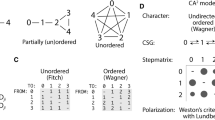Abstract
The molecular mass of a biomolecule is characterized by the monoisitopic mass Mmono and the average isotopic mass Mav. We found that tryptic peptide masses mapped on a plane made by two parameters derived from Mmono and Mav form a peculiar feature in the form of a ‘band gap’ stretching across the whole ‘peptide galaxy’, with a narrow line in the centre. The purpose of this study was to investigate possible reasons for the emergence of such a feature, provided it is not a random occurrence. The a priori probability of such a feature to emerge by chance was found to be less than 1:100. Peptides contributing to the central line have elemental compositions following the rules S = 0; Z = C - (N + H)/2 = 0, which nine out of 20 amino acid residues satisfy. The relative abundances of amino acids in the peptides contributing to the central line correlate with the consensus order of emergence of these amino acids, with ancient amino acids being overrepresented in on-Line peptides. Since linear correlation between Mav and Mmono reduces the complexity of polypeptide molecules, and the turnover rate of less complex molecules should be faster in non-equilibrium abiotic synthesis, we hypothesize that the line could be a signature of abiotic production of primordial biopolymers. The linear dependence between the average isotopic masses and monoisotopic masses may have influenced the selection of amino acid residues for terrestrial life.
Similar content being viewed by others
References
Artemenko K.A., Zubarev A.R., Samgina T.Yu., Lebedev A.T., Savitski, M.M., Zubarev R.A., 2D Mass Mapping as a General Method of Data Representation in Comprehensive Analysis of Complex Molecular Mixtures, Anal. Chem., 2009, 81, 3738–3745
Zubarev R.A., Some Second-order Errors in Average Mass Measurements of Complex Biological Molecules in Time-of-flight Particle Desorption Mass Spectrometry, Int. J. Mass Spectrom. Ion Processes, 1991, 107, 17–27
Demirev P.A., Zubarev R.A., Probing Combinatorial Library Diversity by Mass Spectrometry, Anal. Chem., 1997, 69, 2893–2900
http://physics.nist.gov/cgi-bin/Compositions/stand_alone.pl?ele=&ascii=html&isotype=some, downloaded 07/29/2008.
Kroopnick P., Craig H., Atmospheric Oxygen; Isotopic Composition and Solubility Fractionation, Science, 1972, 175, 54–55
Trifonov E.N., The Triplet Code from First Principles, J. Biomol. Struct. Dynamics, 2004, 22, 1–11
Zuckerkandl E., Derancourt J., Vogel H., Mutational trends and random processes in the evolution of informational macromolecules, J. Mol. Biol., 1971, 59, 473–490
Jordan I.K., Kondrashov F.A., Adzhubei I.A., Wolf Y.I., Koonin E.V., Kondrashov A.S., et al., A universal trend of amino acid gain and loss in protein evolution, Nature, 2005, 433, 633–638
Miller S.L., A Production of Amino Acids Under Possible Primitive Earth Conditions, Science, 1953, 117, 528–529
Thiemens M.H., Heidenreich J.E. III, The mass-independent fractionation of oxygen: a novel isotope effect and its possible cosmochemical implications, Science, 1983, 219, 1073–1075
Gao Y.Q., Marcus R.A., Strange and Unconventional Isotope Effects in Ozone Formation, Science, 2001, 293, 259–263
Bada J.L., How life began on Earth: a status report, Earth Planet. Sci. Lett., 2004, 226, 1–15
Wasserburg G.J., Busso M., Gallino R., Nollett K.M., Short-lived nuclei in the early Solar System: Possible AGB sources, Nucl. Phys. A, 2006, 777, 5–69
Author information
Authors and Affiliations
Corresponding author
About this article
Cite this article
Zubarev, R.A., Artemenko, K.A., Zubarev, A.R. et al. Early life relict feature in peptide mass distribution. cent.eur.j.biol. 5, 190–196 (2010). https://doi.org/10.2478/s11535-009-0069-2
Received:
Accepted:
Published:
Issue Date:
DOI: https://doi.org/10.2478/s11535-009-0069-2




